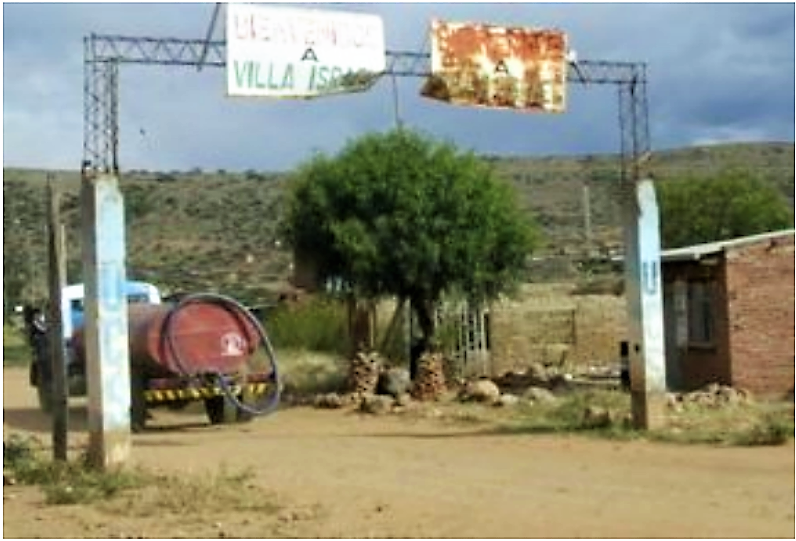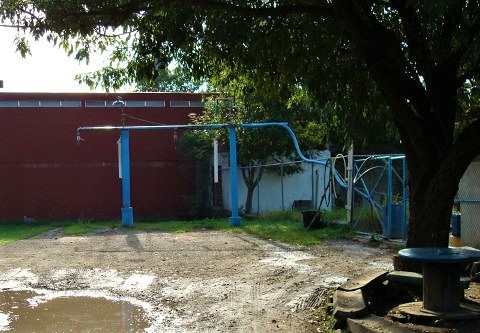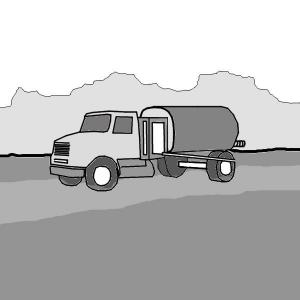Executive Summary
Where there is no or an insufficient supply of piped freshwater and drinking water, water has to be transported either by trucks or by human power. Water trucks with tanks (also known as tank trucks or cistern trucks) bring the water from the sources to the consumers. Motorised water distribution is very important in many countries, especially in urban or peri-urban areas or in emergencies (war, natural disaster). The tank trucks must be maintained well to avoid a (re-) contamination and the water source should be chosen careful to deliver the best water quality as possible.
| In | Out |
|---|---|
Freshwater, Drinkingwater, Energy |
Freshwater, Drinkingwater |
Introduction
In many parts of the world, people lack piped access to water for their daily needs (e.g. hygiene, drinking, cooking, cloth washing etc.). In order to have access to water, people try to help themselves by collecting water for their families and communities by collecting rainwater (see also urban and rural rainwater harvesting and fog drip water collection), by installing shallow wells and a handpump, by getting water by walking to the source or by buying it from a mobile vendor.
Another solution to get water to the people is to collect at the (well, lake, river, spring) and then distribute it with motorised trucks.Water supply trucks are distribution systems by which governments and private entrepreneurs transport water to a central community location or directly to a household. From the trucked tank, the water is either pumped into hand-held containers or if available, directly into household wells or storage tanks (adapted from DRINKING WATER 2010).This type of system may be permanent in communities where no other delivery infrastructure exists and it is an efficient short-term solution in areas with intermittent service due to a natural disaster or emergency (e.g. drought, damage to infrastructure due to war, earthquake, emergency camps, etc.; see also emergency camp and community water supply in emergencies).
In arid areas and those lacking other permanent water infrastructure, water trucks may also be part of the municipal water supply plan. In such cases they are funded by local governments and may present no undue burden to their users. But people living beyond the reach of the water infrastructure, such as those in rapidly growing urban slums or remote countryside locales, may be forced to pay private contractors for truck delivery of their daily water needs. However, water supply with trucks provides only infrequent and/or contaminated water (see also waterborne diseases) and treatment at the point of use is required.

Costs considerations
The price for the water depends on the vendor. For example in Cochabamba, Bolivia, private vendors typically charge 10 to 20 times the fee charged by public utilities, and people living in marginal urban areas pay between 10 and 40 % of their incomes to acquire water in this way (WUTICH 2006).
SOLO (2003) also mentions that trucked water is more expensive than piped water. Her study shows that water is sold 4-10 times of the public network unit price. In their investigations (implemented in Paraguay, Argentina, Colombia, Guatemala, Peru and Bolivia), they did not get confirmation of the numbers mentioned in different literature (20-150 times of the public network unit price).
Operation and maintenance
(Adapted from NHDES 2010)
Equipment surfaces that come into contact with water during transport of fresh or drinking water must be well maintained and be made of material that is smooth, impervious, non-absorbent, corrosion resistant and nontoxic, such as stainless steel. While stainless steel tanks are preferred, aluminium tanks are also allowed. Tanks shall be of the type that can be closed to exclude all foreign matter and vents on tanks shall be protected to prevent contamination of the fresh/drinking water during filling and emptying. Fresh/drinking water should be stored, loaded, transported, and unloaded in a manner that prevents contamination.

Tanks previously used to carry any non-food products, toxic substances, or petroleum products may not be used unless the tank is approved by a responsible institution after the following is completed.
- The tank must be thoroughly cleansed using appropriate sanitation methods to remove all previously transported products.
- The tank should be filled with drinking water and be tested for the presence of contaminants associated with the products previously stored in the tanks and the chemicals used for cleaning.
- The two processes above should be repeated until there is no trace of contaminants.
- Pipes, hoses, fittings, and valves associated with the tank must be replaced with equipment not previously used to transport petroleum products, toxic substances, or any non-food products.
Health aspects
It is not secure that water delivered by tanker trucks is clean (low-quality water). The risk of contamination is always there. This contamination can have different sources;
- Unimproved water source
- Mouldy water (bad and/or a long time of storage)
- Contaminated tanks and work equipment
If users are not sure about the water quality and/or source, treatment at the point of use is suggested. This helps to prevent waterborne diseases.
At a glance
| Working principle | A tank drunk delivers fresh or drinking water to households without an access to a piped water system or during natural disasters, displacement of refugees and emergencies. |
| Capacity/adequacy | Appropriate in all kinds of areas but generally only sustainable as a short-term solution. |
| Performance | Water users are dependent on the government or the organising water distributor. |
| Costs | Higher costs compared to a piped water system. |
| Self-help compatibility | A car mechanic and petrol for trucks is necessary. |
| O&M | The truck and the transport equipment must be maintained well to avoid a contamination of the water. |
| Reliability | As long as the O&M is well, it is reliable. But petrol crisis can lead to non-operation. |
| Main strength | Trucks can bring the water to almost every area. |
| Main weakness | High costs for the end user, high risk of contamination of the water |
Water trucks are used in areas where no piped water distribution exists. That could be in very poor and densely populated areas, in areas where illegal houses were built, in rural places, after a natural disaster (e.g. earthquake, volcanic eruption), or where the piped system was destroyed because of a war.
Water Supply by Vehicle
Environmental Fact Sheet Emergency Bulk Water for Public Water Systems
This factsheet describes how a tank truck should be maintained.
NHDES (2010): Environmental Fact Sheet Emergency Bulk Water for Public Water Systems. New Hampshire: Department of Environmental Services URL [Accessed: 15.06.2011]Environmental Factsheet. Independent Water Entrepreneurs in Latin America
This report outlines the findings of the six-country study (Paraguay, Argentina, Colombia, Guatemala, Peru and Bolivia) of small-scale providers of water supply and sanitation service in Latin America carried out by the Water and Sanitation Program.
SOLO (2003): Environmental Factsheet. Independent Water Entrepreneurs in Latin America. Washington DC: The World Bank URL [Accessed: 17.05.2019]The Effects of Urban Water Scarcity on Sociability and Reciprocity in Cochabamba Bolivia
While much is being done to extend water provision systems to the urban poor, the roots of urban water scarcity are complex and difficult to resolve. Today, as urban water scarcity worsens, research is needed to help mitigate its impact on the environment and human welfare. This study is designed to engage with interdisciplinary scholarship on two practical problems in urban water scarcity:small-scale human-environment interactions and changing survival strategies among the urban poor
WUTICH (2006): The Effects of Urban Water Scarcity on Sociability and Reciprocity in Cochabamba Bolivia. Florida: University of Florida URL [Accessed: 15.06.2011]Compendium of Sanitation Systems and Technologies (Arabic)
This is the Arabic version of the Compendium of Sanitation Systems and Technologies. The Compendium gives a systematic overview on different sanitation systems and technologies and describes a wide range of available low-cost sanitation technologies.
TILLEY, E. ULRICH, L. LUETHI, C. REYMOND, P. SCHERTENLEIB, R. ZURBRUEGG, C. (2014): Compendium of Sanitation Systems and Technologies (Arabic). 2nd Revised Edition. Duebendorf, Switzerland: Swiss Federal Institute of Aquatic Science and Technology (Eawag) PDFEnvironmental Fact Sheet Emergency Bulk Water for Public Water Systems
This factsheet describes how a tank truck should be maintained.
NHDES (2010): Environmental Fact Sheet Emergency Bulk Water for Public Water Systems. New Hampshire: Department of Environmental Services URL [Accessed: 15.06.2011]Environmental Factsheet. Independent Water Entrepreneurs in Latin America
This report outlines the findings of the six-country study (Paraguay, Argentina, Colombia, Guatemala, Peru and Bolivia) of small-scale providers of water supply and sanitation service in Latin America carried out by the Water and Sanitation Program.
SOLO (2003): Environmental Factsheet. Independent Water Entrepreneurs in Latin America. Washington DC: The World Bank URL [Accessed: 17.05.2019]The Effects of Urban Water Scarcity on Sociability and Reciprocity in Cochabamba Bolivia
While much is being done to extend water provision systems to the urban poor, the roots of urban water scarcity are complex and difficult to resolve. Today, as urban water scarcity worsens, research is needed to help mitigate its impact on the environment and human welfare. This study is designed to engage with interdisciplinary scholarship on two practical problems in urban water scarcity:small-scale human-environment interactions and changing survival strategies among the urban poor
WUTICH (2006): The Effects of Urban Water Scarcity on Sociability and Reciprocity in Cochabamba Bolivia. Florida: University of Florida URL [Accessed: 15.06.2011]Source Book of Alternative Technologies for Freshwater Augmentation in Latin America and the Caribbean
The Latin American and Caribbean countries have seen growing pressure on water resources, with increasing demand and costs, for agricultural, domestic and industrial consumption. This has brought about the need to maximize and augment the use of existing or unexploited sources of freshwater. There are many modern and traditional alternative technologies for improving the utility and augmenting the supply of water being employed in various countries, but with limited application elsewhere due to the lack of information transfer among water resources managers and planners. This book was prepared to provide water resource managers and planners, especially in developing countries and in countries with economies in transition, with information on the range of technologies that have been developed and used in the various countries throughout the world.
UNEP (1998): Source Book of Alternative Technologies for Freshwater Augmentation in Latin America and the Caribbean. Nairobi: United Nations Environment Programme (UNEP) URL [Accessed: 17.10.2011]Cleaning and Disinfecting Water Storage Tanks and Tankers
The most common, immediate solution to quickly provide a basic water supply in an emergency is to hire vehicles and tanks that have been used for other purposes or to retrieve collapsible tanks from an emergency store. This technical note outlines a four-step approach to cleaning and disinfecting water tanks and tankers.
GODFREY, S. REED, B. (2013): Cleaning and Disinfecting Water Storage Tanks and Tankers. (= Technical Notes on Drinking-Water, Sanitation and Hygiene in Emergencies , 3 ). Geneva: World Health Organization (WHO) URL [Accessed: 26.08.2013]Delivering Safe Water by Tanker
Water tankering (also known as water trucking) can be a rapid means of transporting water to areas in need during the initial phase of an emergency. Tankering operations, however, are expensive and relatively time-consuming to administer. This technical note considers key issues relating to the effective and efficient use of tankers during an emergency.
REED, B. (2013): Delivering Safe Water by Tanker. (= Delivering Safe Water by Tanker , 12 ). Geneva: World Health Organization (WHO) URL [Accessed: 27.08.2013]Concern does large scale water distribution to 8,000 people in Haiti
This video shows how tank trucks are used in an emergency situation, in this case after the earthquake in Haiti.


